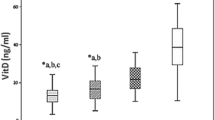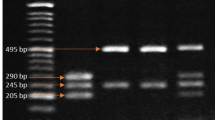Abstract
To assess the association between vitamin D-Binding Protein (VDBP rs7041T>G) and vitamin D receptor (VDR rs1544410G>A) gene polymorphisms with susceptibility to cardiovascular diseases in population from west of Iran. Two hundred forty-nine individuals with cardiovascular disease (92 with aortic and Mitral Valves Calcification (AMVC) and 157 with Coronary Artery Diseases (CAD) that their diseases were confirmed by echocardiography and angiography and unrelated 182 healthy controls (gender and age-matched) were selected for this case–control study. The VDR 1544410G>A, and VDBP 7041T>G genotyping were detected by PCR–RFLP, serum vitamin D and lipid concentrations were measured by ELISA and enzyme assay, respectively. The VDR rs1544410G>A gene is a strong risk factor for CAD (OR = 1.28, p = 0.002) and the dominant genotype (T/G+G/G) of VDBP 7041 T>G SNP plays a protective role (OR = 0.67, p = 0.003) in AMVC development in studied population. In addition, lower level of vitamin D strongly increased the risk of CAD (15 ± 11.02 vs. 21.3 ± 18 μg/L, p = 0.043) and AMVC (12.1 ± 13.1 vs.21.3 ± 18 μg/L, p = 0.014) development in individuals carrying T/T genotype of VDBP 7041 T>G gene polymorphism. There was a strong interaction between A allele VDR rs1544410 and G allele of VDBP rs7041 genes in a protective role (OR = 0.74, p = 0.044) in AMVC patients). CAD and AMVC patients were deficient in vitamin D, i.e. their level of vitamin D was strongly lower than that in the control group. Our findings for the first time indicated that there is a strong association between vitamin D deficiency, lipid profile and the VDR rs1544410G>A and rs7T41>G VDBP genes polymorphisms. These interactions may be one of the important factors for CAD and AMVC incidence.




Similar content being viewed by others
References
Yeh HL, Kuo LT, Sung FC, Yeh CC (2018) Association between Polymorphisms of Antioxidant Gene (MnSOD, CAT, and GPx1) and Risk of Coronary Artery Disease. Biomed Res Int 2018:5086869
Vaisi-Raygani A, Rahimi Z, Entezami H, Kharrazi H, Bahrhemand F, Tavilani H et al (2008) Butyrylcholinesterase K variants increase the risk of coronary artery disease in the population of western Iran. Scand J Clin Lab Invest 68(2):123–129
Wang AY, Ho SS, Wang M, Liu EK, Ho S, Li PK et al (2005) Cardiac valvular calcification as a marker of atherosclerosis and arterial calcification in end-stage renal disease. Arch Intern Med 165(3):327–332
Martinez PF, Okoshi MP (2018) Genetic risk in coronary artery disease. Arq Bras Cardiol 111(1):62–63
Hu N, Wang J, Hu P, Li Z (2018) Investigation of Renalase gene rs2576178 polymorphism in patients with coronary artery disease. Biosci Rep 38(5):BSR20180839
Mirhosseini N, Rainsbury J, Kimball SM (2018) Vitamin D supplementation, serum 25(OH)D concentrations and cardiovascular disease risk factors: a systematic review and meta-analysis. Front Cardiovasc Med 5:87
Hao Y, Chen Y (2019) Vitamin D levels and vitamin D receptor variants are associated with chronic heart failure in Chinese patients. J Clin Lab Anal 33:e22847
Norman PE, Powell JT (2005) Vitamin D, shedding light on the development of disease in peripheral arteries. Arterioscler Thromb Vasc Biol 25(1):39–46
Stakisaitis D, Lesauskaite V, Girdauskaite M, Janulionis E, Ulys A, Benetis R (2016) Investigation of vitamin D-binding protein polymorphism impact on coronary artery disease and relationship with longevity: own data and a review. Int J Endocrinol 2016:8347379
Abdella NA, Mojiminiyi OA (2018) Vitamin D-binding protein clearance ratio is significantly associated with glycemic status and diabetes complications in a predominantly vitamin D-deficient population. J Diabetes Res 2018:6239158
Thrailkill KM, Jo CH, Cockrell GE, Moreau CS, Fowlkes JL (2011) Enhanced excretion of vitamin D binding protein in type 1 diabetes: a role in vitamin D deficiency? J Clin Endocrinol Metab 96(1):142–149
Lu S, Guo S, Hu F, Guo Y, Yan L, Ma W et al (2016) The associations between the polymorphisms of vitamin D receptor and coronary artery disease: a systematic review and meta-analysis. Medicine (Baltimore) 95(21):e3467
Amadori D, Serra P, Masalu N, Pangan A, Scarpi E, Bugingo AM et al (2017) Vitamin D receptor polymorphisms or serum levels as key drivers of breast cancer development? The question of the vitamin D pathway. Oncotarget 8(8):13142–13156
Santos BR, Lecke SB, Spritzer PM (2017) Genetic variant in vitamin D-binding protein is associated with metabolic syndrome and lower 25-hydroxyvitamin D levels in polycystic ovary syndrome: a cross-sectional study. PLoS ONE 12(3):e0173695
Chen H, Zhang L, He Z, Zhong X, Zhang J, Li M et al (2015) Vitamin D binding protein gene polymorphisms and chronic obstructive pulmonary disease: a meta-analysis. J Thorac Dis 7(8):1423–1440
Triantos C, Aggeletopoulou I, Kalafateli M, Spantidea PI, Vourli G, Diamantopoulou G et al (2018) Prognostic significance of vitamin D receptor (VDR) gene polymorphisms in liver cirrhosis. Sci Rep 8(1):14065
Bahrehmand F, Vaisi-Raygani A, Kiani A, Rahimi Z, Tavilani H, Navabi SJ, Shakiba E, Hassanzadeh N, Pourmotabbed T (2012) Matrix metalloproteinase-2 functional promoter polymorphism G1575A is associated with elevated circulatory MMP-2 levels and increased risk of cardiovascular disease in systemic lupus erythematosus patients. Lupus 21(6):616–624
Hong YJ, Kang ES, Ji MJ, Choi HJ, Oh T, Koong SS et al (2015) Association between Bsm1 Polymorphism in vitamin D receptor gene and diabetic retinopathy of type 2 diabetes in korean population. Endocrinol Metab (Seoul) 30(4):469–474
Martineau AR, Leandro AC, Anderson ST, Newton SM, Wilkinson KA, Nicol MP et al (2010) Association between Gc genotype and susceptibility to TB is dependent on vitamin D status. Eur Respir J 35(5):1106–1112
Shanker J, Maitra A, Arvind P, Nair J, Dash D, Manchiganti R et al (2011) Role of vitamin D levels and vitamin D receptor polymorphisms in relation to coronary artery disease: the Indian atherosclerosis research study. Coron Artery Dis 22(5):324–332
Paradis JM, Fried J, Nazif T, Kirtane A, Harjai K, Khalique O et al (2014) Aortic stenosis and coronary artery disease: what do we know? What don’t we know? A comprehensive review of the literature with proposed treatment algorithms. Eur Heart J 35(31):2069–2082
Alizadeh S, Djafarian K, Alizadeh H, Mohseni R, Shab-Bidar S (2017) Common variants of vitamin D receptor gene polymorphisms and susceptibility to coronary artery disease: a systematic review and meta-analysis. J Nutrigenet Nutrigenomics 10(1–2):9–18
Nikpay M, Goel A, Won HH, Hall LM, Willenborg C, Kanoni S et al (2015) A comprehensive 1000 Genomes-based genome-wide association meta-analysis of coronary artery disease. Nat Genet 7(10):1121–1130
Manousaki D, Mokry LE, Ross S, Goltzman D, Richards JB (2016) Mendelian randomization studies do not support a role for vitamin D in coronary artery disease. Circ Cardiovasc Genet 9(4):349–356
Hossein-Nezhad A, Eshaghi SM, Maghbooli Z, Mirzaei K, Shirzad M, Curletto B et al (2014) The role of vitamin D deficiency and vitamin d receptor genotypes on the degree of collateralization in patients with suspected coronary artery disease. Biomed Res Int 2014:304250
Rezavand N, Tabarok S, Rahimi Z, Vaisi-Raygani A, Mohammadi E, Rahimi Z (2018) The effect of VDR gene polymorphisms and vitamin D level on blood pressure, risk of preeclampsia, gestational age, and body mass index. J Cell Biochem Nov 120(4):6441–6448
Ortlepp JR, Hoffmann R, Ohme F, Lauscher J, Bleckmann F, Hanrath P (2001) The vitamin D receptor genotype predisposes to the development of calcific aortic valve stenosis. Heart 85(6):635–638
Hassani H, Djafarian K (2017) Vitamin D receptor gene polymorphisms and risk of coronary artery disease: findings from a meta-analysis with 5259 cases. Razi J Med Sci 24(160):79–89
Chan YH, Yiu KH, Hai JJ, Chan PH, Lam TH, Cowling BJ et al (2017) Genetically deprived vitamin D exposure predisposes to atrial fibrillation. Europace 19(suppl_4):iv25–iv31
Daffara V, Verdoia M, Rolla R, Nardin M, Marino P, Bellomo G et al (2017) Impact of polymorphism rs7041 and rs4588 of Vitamin D Binding Protein on the extent of coronary artery disease. Nutr Metab Cardiovasc Dis 27(9):775–783
Mostafavi A, Khavandi S, Jafarnejad S, Naderian MM, Akbarzadeh M, Farbod Z (2018) Evaluation of correlation between serum levels of vitamin D and coronary artery disease: an existing debate. J Clini Diag Res 12(8):1–4
Akin F, Ayca B, Kose N, Duran M, Sari M, Uysal OK et al (2012) Serum vitamin D levels are independently associated with severity of coronary artery disease. J Investig Med 60(6):869–873
Young KA, Snell-Bergeon JK, Naik RG, Hokanson JE, Tarullo D, Gottlieb PA et al (2011) Vitamin D deficiency and coronary artery calcification in subjects with type 1 diabetes. Diabetes Care 34(2):454–458
Sun H, Long SR, Li X, Ge H, Liu X, Wang T et al (2019) Serum vitamin D deficiency and vitamin D receptor gene polymorphism are associated with increased risk of cardiovascular disease in a Chinese rural population. Nutr Res 61:13–21
Acknowledgements
This study was funded by NIMAD, Iran; Grant #958709.
Author information
Authors and Affiliations
Corresponding author
Ethics declarations
Conflict of interest
All authors declare that they have no conflict of interest.
Additional information
Publisher's Note
Springer Nature remains neutral with regard to jurisdictional claims in published maps and institutional affiliations.
Rights and permissions
About this article
Cite this article
Kiani, A., Mohamadi-Nori, E., Vaisi-Raygani, A. et al. Vitamin D-binding protein and vitamin D receptor genotypes and 25-hydroxyvitamin D levels are associated with development of aortic and mitral valve calcification and coronary artery diseases. Mol Biol Rep 46, 5225–5236 (2019). https://doi.org/10.1007/s11033-019-04979-1
Received:
Accepted:
Published:
Issue Date:
DOI: https://doi.org/10.1007/s11033-019-04979-1




